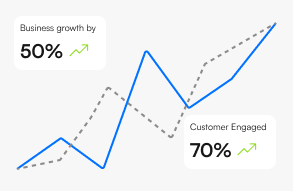NLP Chatbots: Simplifying Complex Interactions with AI

Rajesh Bhattacharjee
December 18, 2023
3 min

Table of Contents
In the realm of customer service, NLP (Natural Language Processing) chatbots, including advanced systems like ChatGPT, have marked a significant evolution. These AI-driven tools are reshaping how businesses interact with customers, offering a blend of efficiency and human-like interaction.
What is an NLP Chatbot?
An NLP chatbot is an advanced software tool designed to comprehend and reply to human language. These custom ai chatbots, powered by AI technologies like ChatGPT, go beyond basic keyword recognition. They interpret the context and nuances of human speech, facilitating natural and engaging conversations.
Evolution from Rule-Based to NLP Chatbots
Initially, chatbots were rule-based, limited to responding with predefined answers and unable to handle complex queries. NLP chatbots, however, use AI to understand the full context of a customer’s message, providing more accurate and relevant responses.
Understanding NLP, NLU, and NLG
1. Natural Language Processing (NLP)
This field of AI empowers machines to interpret, examine, and react to human speech or text, enhancing the interaction between humans and bots.
2. Natural Language Understanding (NLU) A subset of NLP, NLU focuses on machine comprehension, ensuring the bot understands the meaning behind linguistic input.
3. Natural Language Generation (NLG)
Another subset of NLP, NLG involves the bot creating automatic replies in natural language, effectively answering customer queries.
Key Elements of NLP-Powered Bots
- Dialogue Management: Tracks the conversation's state, including context and session management.
- Human Handoff: Seamlessly transfers conversations from the AI chatbot to a human agent when necessary.
- Business Logic Integration: Programs the chatbot with unique business rules for relevant responses.
- Rapid Iteration: Allows for quick updates and improvements to the chatbot's responses.
- Training and Iteration: Systematic training using real-world data enhances the chatbot's understanding of customer intents.
Generative AI and ChatGPT in Chatbots
The rise of generative AI, exemplified by ChatGPT, represents a new era in NLP. Unlike traditional models, these bots can generate original responses, adapting to a wide range of customer inquiries with greater accuracy.
How Do NLP Chatbots Work?
The functionality of NLP chatbots involves several steps:
- Normalizing: Simplifying text to a standard format..
- Tokenizing: Breaking down messages into smaller components for analysis.
- Intent Classification: AI-classified intent determines the purpose behind a customer's message.
- Entity Recognition: Identifies key elements like dates and numbers in the message.
- Response Generation: Crafts appropriate replies based on the analysis.
The ROI of Chatbots in Business
NLP chatbots offer significant Return on Investment (ROI) by enhancing customer experience, providing 24/7 service, reducing operational costs, and scaling with business needs.
Conclusion
Chatbots using NLP, especially those driven by generative AI such as ChatGPT, are revolutionizing AI and customer service tech. They deliver interactions that are more fluid, effective, and accurate, improving the customer journey and giving companies a robust tool for managing communication. With ongoing advancements in this technology, its significance in business tactics and customer support is expected to grow increasingly central.

Grow Your Business with AI Chatbots
- Automate tasks
- Engage customers 24/7
- Boost conversions